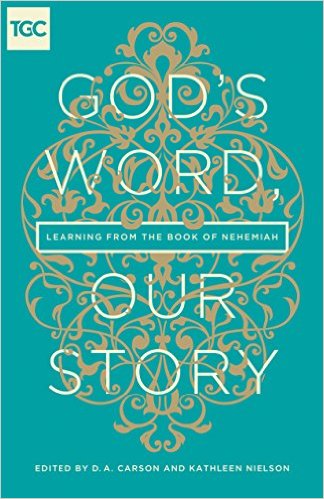Our women’s initiatives team finds a lot of interest these days in training women to study and teach the Bible in the context of the local church. Many women who come to our conferences or access our resources are pursuing in-depth study of the Scriptures, and they’re always looking for materials to help spur them on. Many pastors are also looking for ways to encourage and guide women in their congregations to “dig in” to the Word more deeply and to teach it to other women.

This fact that narrative is story is obvious and basic, but we should notice it—and delight in it. Scripture’s stories are not a decorative shell for theological truth; they are the revelation of God to us, in all the details of their “story-ness.” Old Testament narratives are true stories, to be sure; these stories give us the real live history of our faith, telling us what actually happened, generation after generation. But these true stories are shaped, selective, full of artistry—great gifts from a Creator God.
Stories Are Universal
Stories are universal. People throughout human history and throughout the diverse cultures of the world all tell stories in one way or another. In fact, one profitable way to study the history of any civilization is to study its stories. That the impulse to create and relish stories transcends culture must be one reason God amply filled with story this Word that he purposed to send out to all the nations. As we consider the genre of narrative we should remember that its beauties (and all the Bible’s literary beauties) are part of God’s gracious means not just to grow and nourish believers but also to draw new believers to himself. I’ve seen many a woman come to Bible study and be drawn into the details and the power of a story she doesn’t yet understand but which somehow moves her and connects with her.

Stories do tend to draw people—all kinds of people. Is there anyone reading this who has not been asked by a child, “Tell me a story”? But why do people love stories? Perhaps it’s because God made us human beings to live in place and time and flesh and blood—which is where stories happen. We’re all living out stories . . . seeing them unfold . . . waiting for the end! We all recognize and resonate with universal themes that stories treat, themes of beginnings and endings, birth and death, family, hope, grief, love, loss, good vs. evil, seasons and harvests, longing for home, and on and on (see Leland Ryken’s Words of Delight).
I find it fascinating that my pre-school granddaughter regularly asks to have this or that event in her life recounted by an omniscient narrator (me), with herself as the third-person heroine. Events that involve discipline are popular requests. “Tell it to me in a story,” says Adelyn. And so I begin: “Late one afternoon, Adelyn went into the kitchen, smelled and then glimpsed the yummy chocolate cookies on the counter, glanced around and saw that no one was watching . . .” It’s not like she doesn’t know what’s going to happen! But she’s transfixed by her story. I think all of us human beings are transfixed by our stories.
Stories Are Concrete
Stories are concrete. One of the distinguishing features of narrative is that it invites us in to concrete experience, not just abstract idea. Often we think of the apostle Paul’s theological propositions as the Bible’s real, hard stuff, and story and poetry as the more ethereal fluff. Actually, theological propositions, crucial as they are, can be pretty abstract and heady—whereas story deals with stuff like feasts with lots of food and drink, broken down walls, women getting pregnant, battles and blood, sheep, bread, and all of the physical reality where we live and where God is working moment by moment.
Many of us have observed (or used to be) giggling young readers who found and marked certain graphic parts of the Bible that are fun to read—again and again. How about that story from Judges 3 of Ehud thrusting his sword into the very fat belly of King Eglon? In vivid detail, the text says the hilt went in after the blade, and the fat closed over the blade . . . and that’s not all it says! Scripture’s narratives are remarkably concrete, and that’s the nature of story: to give us real experience in a concrete place and time.
The scene from Nehemiah 2 in which sad-faced Nehemiah serves wine to the Persian king, Artaxerxes (with the queen sitting right beside him, we’re told) ushers us right into the tension of that particular moment in the presence of royalty—which contrasts starkly with the later scene from that same chapter in which Nehemiah, safely in Jerusalem, rides out at night “by the Valley Gate to the Dragon Spring and to the Dung Gate” to inspect the broken-down walls and fire-destroyed gates (v. 13). We may not know exactly where each named gate, spring, and pool was located, but as Nehemiah rides past them one by one, we are transported along with him in this memorable nighttime inspection tour, passing burned-down gate after burned-down gate, along the rubble of Jerusalem’s wall. The scene feels both surreal and desolately real.
Stories Are God's Revelation of Himself
These concrete stories fill the Scriptures. They are our history as God’s people, and God is gracious to “tell it to us in a story.” Over a third of the Old Testament comes to us in narrative form, giving us salvation history through the true stories of real people who lived it out. God clearly wants us to pay close attention to the details of these stories; they’re definitely not just for the children!
Steven Mathewson comments that “many churches teach Bible stories to children downstairs in the basement while the adults study Paul’s epistles upstairs in the auditorium” (The Art of Preaching Old Testament Narrative). No—we all need to hear these stories that fill the Scriptures, and we need to hear them taught. Even as we receive them and delight in them in the narrative form God inspired, we must remember that they are true and that their truth instructs us. As John Piper has reminded us in chapter five of God’s Word, Our Story:
There is a point to the narrative—and the point is a person. . . . Biblical stories are no more ends in themselves than history is an end in itself, or the universe is an end in itself. The universe is telling the glory of God (Ps. 19:1). And the history of the world is what it is to show that God is who he is. God writes the story of history to reveal who he is—what he is like, his character, his name.
Editors’ note: Join us next month for our National Women’s Conference, June 16 to 18 in Indianapolis. Space is running out, so register soon!
Is there enough evidence for us to believe the Gospels?
 In an age of faith deconstruction and skepticism about the Bible’s authority, it’s common to hear claims that the Gospels are unreliable propaganda. And if the Gospels are shown to be historically unreliable, the whole foundation of Christianity begins to crumble.
In an age of faith deconstruction and skepticism about the Bible’s authority, it’s common to hear claims that the Gospels are unreliable propaganda. And if the Gospels are shown to be historically unreliable, the whole foundation of Christianity begins to crumble.



































